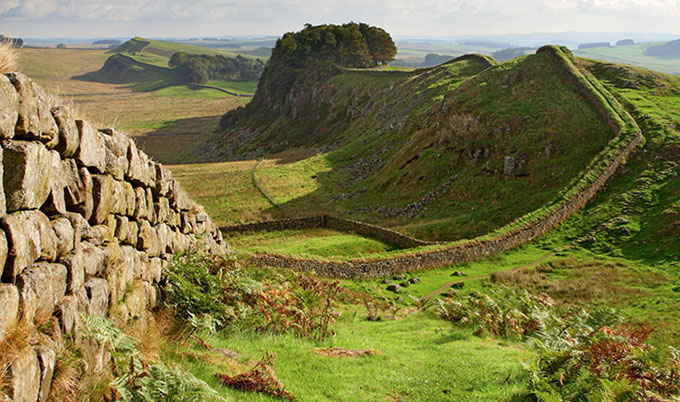WallCAP review
Volunteers make progress in saving Hadrian’s Wall
Published on: 24 January 2020
Archaeologists at Newcastle University are thanking community volunteers for their help in protecting, preserving and interpreting the remains of Hadrian's Wall.
Vital heritage
The National Lottery-funded WallCAP project was launched in 2019, and in its first year has recruited more than 200 volunteers to understand more about the condition of the wall and help prevent further deterioration.
Stretching 135km from one side of the country to the other, the UNESCO World Heritage Site is at risk from modern threats such as severe weather, wear and tear from tourism and damage caused by grazing animals and invasive plant species.
Led by Newcastle University, the three year project is training people in specialist skills such as digital surveying and terrestrial laser scanning, as well as conservation and geological work.
As the project moves into its second year, the WallCAP team will highlight some of its successes so far and outline plans for 2020 at a community event for volunteers and partners at Carlisle racecourse on Saturday 22 February. The 'Hadrian's Wall networking day' event is open to current volunteers and anyone interesting in joining the project.
Dr Rob Collins, WallCAP project manager and Lecturer in Archaeology, Newcastle University, said:
“January 24th marks the birthday of Emperor Hadrian so it seems fitting that we celebrate this by applauding the excellent work of the WallCAP volunteers. Thanks to their efforts, we are gaining a much better understanding of the Wall and are in a much better position to ensure its survival.
“There is still lots to do and we have many exciting activities planned for 2020 and beyond, so there will be many more opportunities for communities along the Wall to take part. Together, we can conserve a vital part of our heritage and ensure that it can be enjoyed by future generations of local communities and visitors for many more years to come.”

Community archaeology
The activities carried out by the WallCAP volunteers in 2019 included new excavation work at Corbridge Roman Town. In August, despite two weeks of heavy rain, a team of more than 50 volunteers from the local community and archaeology students at Newcastle University uncovered a Roman street surface and many fragments of Roman pottery, as well as revealing the remains of what is thought to be a small Roman building.
Also, a specially-trained corps of volunteers called WallWatch have continued to complete condition surveys of the monument every six months. These surveys act as an early warning system for any damage or potential dangers to the archaeology. This year will see an expansion of this scheme to include even more parts of the World Heritage Site.
The WallCAP project is also aiming to answer the question Where is our Wall? encouraging people to solve the mystery of the missing stones from Hadrian’s Wall. For more than 1,500 years, stones quarried by the Romans have been taken from the Wall to build local houses, farm buildings and field walls. Some of the best known churches and castles along the length of the Wall were built with stones taken from Hadrian’s Wall, such as Hexham Abbey, Brampton Old Church and Thirlwall Castle, located near the village of Greenhead, Northumberland.
Throughout last year, WallCAP volunteers went on guided field excursions exploring the geology from coast to coast. In July 2019, they carried out a geophysical survey of the fields around Thirlwall Castle using the latest digital and scientific techniques, which confirmed the line of Hadrian’s Wall. They also scanned the southern elevation of the castle to produce a highly detailed 3D map to discover more about how the Wall has been recycled.
Recording in detail what the castle stones are made of and exploring the geology onto which the Wall and the Castle have been built helps understand how the landscape has influenced the route of the wall and the material used in its construction. Combining this with examining and measuring the size, shape and surface markings of the castle stones gives them the knowledge needed to recognise Roman stone which has been re-used in other constructions.
Dr Ian Kille, WallCAP Community Geologist, said:
“The volunteers really enjoyed exploring the geology and landscape of the area and have made some excellent observations about the stones at Thirlwall Castle and how they relate to the underlying geology. This gives us an excellent starting point from which we can continue to explore the geology and carry out further investigations to find out more about the extent to which stones from Hadrian’s Wall have been re-used, and how much other lost Wall material is still to be accounted for.”
In 2020 the team will return to Thirwall Castle and use the results of the surveys to carry out targeted excavation work.
Anyone interested in volunteering for the WallCAP project can register at wallcap.ncl.ac.uk Registered volunteers receive regular updates to alert them of forthcoming opportunities and events - including fieldwork - to investigate and protect the Wall.
The Hadrian's Wall networking day event for volunteers and partner organisations will take place on 22 February, 10am - 5pm, at Carlisle racecourse. Places are free but on a first come first served basis. To sign up to attend, please visit https://www.eventbrite.com/e/hadrians-wall-networking-day-2020-tickets-86493673907



